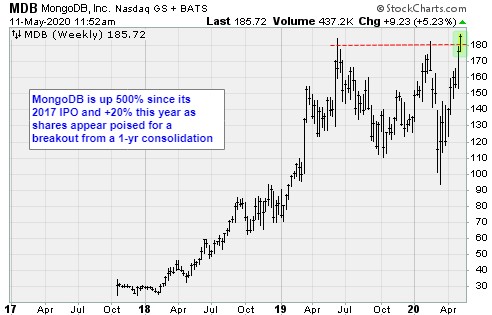Ingenious New-Age Database Maker Flies Under the Radar
I have a riddle for you: What is the size of a tennis court, filled with helium and might be your lifeline to the internet in the next natural disaster?
Stumped? I’m not surprised. That’s because the answer is a Loon balloon, a recent project currently in development.
On Friday, AT&T Corp. (T) and Project Loon partnered to use high-altitude balloons for network connectivity in cases of flood, earthquake and other natural calamities. It’s another example of next-generation tech changing what is possible.
It’s also a big opportunity for investors in data management.
You might remember Project Loon from when Google announced the “moonshot” company six years ago. It was the kind of big, ambitious idea that earned the search giant a reputation for squandering shareholder cash. Like the Google Glass — the always on, augmented reality eyeglasses — Loon seemed frivolous. Critics called it an expensive solution looking for problem.
At the time, it was easy to understand the doubt.
For starters, Loon balloons are essentially floating cell towers on the edge of space. Engineers needed to find a way to choreograph the giant polyethylene bubbles while dealing with extreme temperatures and winds that could reach 60 mph. Their solution involved solar powered pumps to regulate elevation, and lots of data analytics. In the early going, it was hit and miss.
A pilot program in 2013 brought impressive connection speeds to unserved parts of rural New Zealand. Unfortunately, according to a story in the New Zealand Herald, service costs reached $1,000 per month.
That lofty figure excluded material science research costs and the tireless work of engineers developing new patch antenna systems and machine learning software.
In 2016, Project Loon had a breakthrough. Managers discovered that by allowing algorithms to interpret data and dictate the flight paths, balloon fleets became more efficient. Software directed some balloons to loiter over big land masses while others sprinted to new locations.
It was a tightly orchestrated dance of machines and math 12.5 miles above the Earth’s surface.
According to a corporate blog post in July 2019, Project Loon reached one million hours of flight.
And now, the new agreement with AT&T harnesses that progress. It also complements AT&T’s competitive advantages. The company is the largest mobile network operator in the United States. Through its affiliates, customers can access voice and data coverage in 210 countries. In an emergency, these relationships will help Project Loon slice through red tape.
For example, Peru was devastated in 2019 by a magnitude 8.0 earthquake. Communication infrastructure was knocked all over the country. Within 48 hours Loon balloons were overhead and servicing customers thanks to a pre-existing relationship with Telefonica, a local mobile network operator. But ultimately, it was the data crunching algorithms that really made this possible.
Thus, the opportunity for investors is the software platforms engineers use to develop innovative new algorithms.
MongoDB, Inc. (MDB) is a cloud-based, next-generation database platform. The company was founded in 2008 by Dwight Merriman, Kevin Ryan and Eliot Horowitz, the same trio that built and later sold DoubleClick to Google for $1.5 billion in 2005.
They saw a big opportunity to develop a new document database architecture from the ground up. It could be developer friendly and unmoored from legacy relational databases. MongoDB leveraged emerging technologies like cloud, mobile and the internet. The timing was perfect.
CEO Dev Ittycheria told CNBC last March that its Atlas platform hit a $100 million run rate in less than three years and the business was growing at 400% year-over-year.
The versatility of the MongoDB product suite has led to a who’s who of customers. Companies like Alphabet (GOOGL), Facebook (FB), Cisco Systems (CSCO), Adobe Systems (ADBE), Intuit (INTU), PayPal (PYPL), Verizon (VZ), AT&T and others all depend on the New York company to help developers build better products using data.
The stock is not cheap. At $176.49, shares trade at 24 times sales. That is a 645% gain since MongoDB’s 2017 initial public offering. The stock is up 34% in 2020.
Investors have been willing to pay a big premium because overall sales growth since 2017 has averaged 58%. Fiscal 2020 revenues, for example, surged 58% to $421 million. And analysts expect the total addressable market will surge to $80 billion by 2022.
The demand for data management software seems insatiable. Then again, it makes sense when you consider living in a world where engineers have figured out a way to move cell towers around the globe without laying concrete foundations and forging steel.
The world is changing. Data, algorithms and software are the future. Put MongoDB on your watch list.
Best wishes,
Jon D. Markman





